Posted on 22 Oct 2024
For over 20 years, the opioid crisis in North America has claimed hundreds of thousands of lives, primarily due to over-prescribing by doctors and marketing by pharmaceutical companies of powerful opioid-based painkillers, which has led millions of people into addiction. While it appears that Europe has largely avoided an epidemic on the scale of the US, there is a notable lack of information regarding the potential for a synthetic opioid crisis on the continent.
However, there is concern that the opium ban imposed by the Taliban in 2022 may disrupt Europe’s heroin supply chains, sparking fears that drug traffickers might turn to synthetic opioids either to cut heroin or substitute it entirely. Furthermore, the Russian invasion of Ukraine has disrupted the northern heroin supply route to Europe, as evidenced by the ongoing diminished supply of heroin in Ukraine.
Although Europe’s heroin market could face significant disruption from the ban on opium, it remains unclear whether this will translate into a synthetic opioid crisis. The lack of comprehensive data and the gaps in understanding the synthetic opioid market in Europe make it difficult to assess the true scope of the risk. As a result, Europe could be blindsided by a crisis similar to the one seen in North America, an alarm that has been sounded by many in the past year.
Changing opioid supply chains
While concerns about the impact of synthetic opioids are growing, the true nature of Afghanistan’s heroin supply is far from being fully understood. Although the UN Office on Drugs and Crime reports a 95% drop in poppy cultivation in 2023, recent research suggests that opium poppy continues to be grown in several regions. Other analysis also shows trends in continued cultivation in remote areas, such as Badakhshan. Similarly, the German federal criminal police believe that the perceived decline in poppy cultivation has been less dramatic than reported and that no noticeable shortage of heroin is to be expected on the German market. There is also evidence of large opium stockpiles in Afghanistan, and ongoing major seizures along the supply chain to Europe would seem to suggest continued supply. Several seizures show that heroin is still reaching Europe via its regular routes across the Balkan region.
Nevertheless, heroin reaching the European market is showing a gradual decline in quality and there is an increase in wholesale prices in some countries. However, these trends pre-date the opium ban, and it remains uncertain whether the ban has exacerbated them.
The first opium ban in Afghanistan, imposed in 2000, led to a reduced supply of heroin in Europe and at the same time legally produced fentanyl found its way into illicit markets, particularly in the Baltic states. In Estonia, which experienced its first fentanyl crisis in the early 2000s, heroin has since been effectively replaced by fentanyl and its analogues, leading to an increase in overdose deaths. But heroin shortages do not necessarily translate into increased demand for alternative opioids. In Ukraine, for example, after the 2022 Russian invasion, many heroin users switched to synthetic stimulants, such as cathinones, instead.
The silent spread of synthetic opioids
Today, there is growing evidence of a gradual but mostly silent entry of synthetic opioids into the European market, both of fentanyl and its derivatives, and of the highly potent and lethal nitazenes – another opioid drug group originally developed in the 1950s by pharmaceutical companies but never marketed because of the high overdose risks. This is reflected in test results, seizures and spikes in synthetic opioid-related overdose rates in some European countries. However, despite the known potential threat, there is little understanding of the presence and spread of these drugs, as it is more difficult to identify trends in their trafficking patterns compared with other new psychoactive substances, for a number of reasons.
First, the quantities supplied are minimal compared with other drugs, given the extremely high potency of fentanyl and nitazenes. Trafficking in these synthetics is typically in grams, rather than in hundreds of kilos or tonnes, as with plant-based drugs. Between 2011 and 2021, the number of individual seizures of heroin in Europe fell by more than 40%, while the total amount seized increased significantly, by around 50%, signalling a trend towards larger shipments in fewer transactions. However, the volume of fentanyl seized annually to date averages less than 50kg, so seizure trends of a few kilograms have little analytical value.
Secondly, synthetic opioids in Europe are often not sold under their brand names, but are used as adulterants to enhance the perceived quality of heroin, or as counterfeit and falsified medicines, mixed with analgesics or benzodiazepines, as has recently been the case in Ireland and the Netherlands. Field research in Europe suggests that there is a widespread fear of poisoning with synthetic opioids in local drug markets, and that, unlike in the US, there is no demand for these substances as such.
Thirdly, there is a major gap in testing for synthetic opioids in fatal overdoses. In Germany, for example, autopsies are performed in only 50% of fatal overdose cases. Although autopsies and toxicological analyses can clarify the involvement of synthetic opioids, many countries do not systematically test for these substances. This is particularly the case for nitazenes, given their more recent emergence. According to data submitted by member states to the European Union Drugs Agency (EUDA), there were 163 fatal overdoses involving fentanyl and its derivatives in the EU, Norway and Turkey in 2022. Preliminary data for 2023 shows 150 deaths involving nitazenes in Europe. But without more comprehensive testing, the true number of synthetic opioid-related deaths in Europe could be much higher.
A 2023 study by the German NGO Deutsche Aidshilfe found fentanyl in 50 out of 1 401 heroin samples tested across seven German sites. Positive tests occurred in all of the study sites, with the highest prevalence in Hamburg. Similar patterns of contaminated heroin, albeit with nitazenes, have been found in Wales and Canada. The EUDA reports that 20 European countries have detected and seized nitazenes since 2019. And only in 2023, out of seven newly detected synthetic opioids in Europe, six belonged to the group of deadly nitazenes. From 2009 to 2022, EU authorities identified a total of 74 new opioids emerging on European drug markets. In 2023, there were spikes in overdoses related to nitazenes in Estonia, Latvia, France, Ireland and in the United Kingdom.
What is the risk for Europe?
Unlike the US, in Europe the fact there is not widespread medical prescribing of opioids appears to limit the primary risk group of synthetic opioids to heroin users and consumers of falsified or counterfeit medicines. However, with an estimated 1 million high-risk opioid users in Europe, any proliferation of synthetic opioids – whether through contaminated heroin, counterfeit medicines or a shift to fentanyl, as has been the case in Estonia – could spread quickly.
In addition, early results of our European Emerging Drug Trends Monitor show that there is widespread demand and availability of prescription opioids such as oxycodone, tramadol, tilidin and fentanyl patches in European drug markets, which could serve as an unexpected hidden entry points for even more dangerous synthetic opioids.
Although international cooperation, early warning systems and Europe’s healthcare infrastructure might help mitigate these risks, in 2023 European authorities were taken by surprise by outbreaks of nitazene-related overdoses in several countries. Despite steps taken to be prepared and improve testing and drug checking infrastructure, detection capabilities in Europe remain limited, and there may be more drug fatalities in the near future. Without in-depth analysis of the synthetic opioid supply chains into Europe, an understanding of wider drug supply chains and a clear grasp of domestic production levels, Europe runs the risk of not fully anticipating an emerging drug market that may dwarf any previous drug-related public health threats.



